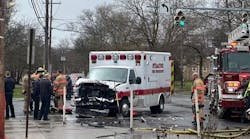Firefighting is more than a career. It's a passion that most smoke-eaters share. You study and drill endlessly, preparing for that one moment where life or death could possibly hang in the balance, but how can you be sure you're physically up to the task?
Have no fear, I've prepared a simple Fitness Evaluation (administered at home or in the firehouse) that will give you a good idea where you stand. Our evaluation starts off with a written exam that includes six yes or no questions.
Part 1: Written Evaluation
- Do you routinely get out of breath going up and down multiple flights of stairs? If yes, adjustment in fitness program indicated (focus cardiovascular endurance)
- Have you noticed an increase in weight, or have you clothes begun to fit a little snugly over the last few years? If yes, adjustment in diet and/or fitness program indicated
- Have you lost any muscular endurance or ability to carry out routine tasks (that were once doable) on the fireground? If yes, adjustment in fitness program indicated (focus power, muscular strength and endurance)
- Do you experience any unexplained physical symptoms at or after fire duty or training (ie: dizziness, nausea, weakness in arms or legs)? If yes, see your doctor before exercising, and notify your department about your symptoms
- Have you had a check up with your physician within the last year? If no, see your doctor before exercising or attempting this program
- Did you know half of all firefighter fatalities are heart attack related? If no, it's time to give yourself an education on the reality on the extremes of firefighting and how you can best prepare yourself
Part 2: Physical Aptitude
To boost your fitness level, visit FirefightersWorkout.com.The FDNY tests it probies at 30 push-ups, 30 sit-ups, and four pull-ups. It also asks it newly hired members to complete a 1.5 mile run in 12 minutes. Certain aspects of the test are easy for some and hard for others. There's also a graded step mill that's considered part of the initial medical exam (heart rate is measured).
Before even entering the academy, every candidate needs to perform 5 minutes and 12 seconds on a graded step-mill at 59 steps per minute. A 50-pound vest simulates bunker gear. Leaning on handrails is not permitted. A passing score is determined by a heart rate of less than 90 percent of max (220 minus age formula is used). There is a three-minute warm up (vest on) before the test begins.
If you don't have access to a step mill, substitute with an eight-inch athletic (or real) step. Don the vest (as an alternative, hold 2 dumbbells) and step at one step per second (alternating legs). Do a 10 second pulse check (and multiply by 6) at the complete of 5 minutes. If you need to stop before 5 minutes, chart the time. Work on improving lower body mid-range endurance before re-testing.
Hint - Learn some basic biofeedback techniques to control heart rate. A heart rate monitor is essential to conscious heart rate control. With the monitor on, sit comfortably, thinking about the most relaxed thoughts you can muster and watch your heart rate drop. Don't try too hard or the reverse will occur? Just relax and let it happen. Apply this same technique while on the step mill.
Classic, straight leg push-ups are performed at a cadence of one-half rep every second (the travel distance from the floor to locked out elbows). Keep your eye on a stop clock (on floor) or use a pace-meter (metronome like device) set to 60 beats per minute to keep your pace smooth. Go all the way down or at least within an inch or two of the floor and lock out the elbows at the top.
As an option, you can perform a standard bench press instead of push-ups. A passing score is reached by pressing half your body weight, ten times.
Hint - To get more oomph into your push-ups, tighten your abs and glutes before you start. The spill over from this extra muscle tension will actually boost strength.
Bent knee sit-ups have long been a favorite of the fire academies and military boot camps. Hands are interlaced behind the head but should NEVER pull on the head or neck. Before beginning, the low back should be flat and abs flexed. A partner holds the feet. Sit all the way up, and roll back down (shoulders touch floor).
Hint - This tip is more of a handicap than a hint. For testing purposes it's okay to bounce up and use momentum to get the 30 reps done, but if this practice is repeated, real strength will never be enhanced. An even pace, without too much bounce is the way to go.
At four reps, this test is still by far the most difficult. Some individuals, for various anatomical reasons, have a hard time with pull ups (palms face away from your body). Don't be too hard on yourself for having long arms or carrying a few extra pounds. If you can't get the 4 reps done, you can substitute with lat pull downs (you'll need access to a lat machine) at half your bodyweight, ten times. Failure here represents the need for upper body strength.
Hint - Pull Ups are a great upper body and grip builder, but so are Lat Machine Pull Downs. Either option will fit the bill.
No physical would be complete without an old fashioned run. This is considered a standard pace (8 minute mile), and not a very long distance. Work up to this gradually in a walk / run fashion if necessary.
Hint - If running isn't your thing, you can substitute with stationary cycle or other cardio machine. Create a challenging goal that's comparable with this 1.5 mile run and takes about 12 minutes to complete (IE: 3 mile on the bike at 70 rpm with pulse rate less than 90 percent max). If you can't keep your heart rate down, cardiovascular endurance needs work.
This is a test of general hip and hamstring flexibility (notoriously tight on most males). Although the FDNY doesn't include a sit and reach test, it's a good measure of overall lower body flexibility.
Simply sit on the floor with legs straight out in front of you. If you can't maintain this starting position, you definitely need work on hamstring, hip, and lower back flexibility. If, on the other hand, you can reach your feet with knees straight, your hip and hamstring flexibility is probably pretty good. Reaching your knees is an indication you need some work in this area.
Hint - Not everybody needs to reach his or her heels. This is a general guideline that needs to be evaluated with all other factors considered.
Summation
The written evaluation includes questions on fitness levels and what you need to do before getting started. Everybody should have a medical before embarking on a new exercise program, not just firefighters, especially if you're experiencing unusual or unexplained symptoms. Remember that knowledge is power. Give yourself an education on what it takes to be firefighter, as well the risks involved.
View test results with a grain of salt, as they're intended to be representative of various qualities (endurance, strength, flexibility, core strength), but are not always accurate with every individual. For example, some of the fittest people I've known could not complete 3 pull-ups.
The goal is to pass each event, an honor worthy of graduating from the FDNY's elite probie school. Passing all 6 events in part 2 also makes you eligible for the FireFighterWorkout.com Academy Certification. E-mail Mike for details.
Captain Mike specializes in both firefighter and candidate fitness programs. To learn more, visit his website: www.firefightersworkout.com




